中低温压力容器用碳钢板SA516Gr60
SA516中低温压力容器用碳钢板
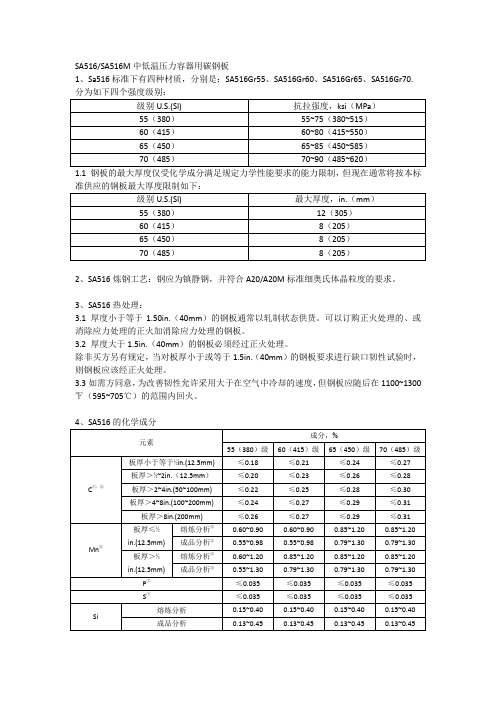
SA516/SA516M中低温压力容器用碳钢板
1、Sa516标准下有四种材质,分别是:SA516Gr55、SA516Gr60、SA516Gr65、SA516Gr70.
准供应的钢板最大厚度限制如下:
2、SA516炼钢工艺:钢应为镇静钢,并符合A20/A20M标准细奥氏体晶粒度的要求。
3、SA516热处理:
3.1 厚度小于等于1.50in.(40mm)的钢板通常以轧制状态供货。
可以订购正火处理的、或消除应力处理的正火加消除应力处理的钢板。
3.2 厚度大于1.5in.(40mm)的钢板必须经过正火处理。
除非买方另有规定,当对板厚小于或等于1.5in.(40mm)的钢板要求进行缺口韧性试验时,则钢板应该经正火处理。
3.3如需方同意,为改善韧性允许采用大于在空气中冷却的速度,但钢板应随后在1100~1300℉(595~705℃)的范围内回火。
①对于熔炼分析和成品分析均适用。
②在规定的最大碳含量以下每降低0.01%,规定最大锰含量的上限可增加0.06%,熔炼分析最大允许到1.50%,成品分析最大允许到1.60%。
③60级厚度不超过½(12.5mm)的钢板锰含量熔炼分析可为0.85%~1.20%,成品分析
0.79%~1.30%。
①用0.2%残余变形法或载荷下的0.5%伸长测定。
②关于伸长率的修正见A-20/A20M标准。
sa516gr60(hic)出自的标准
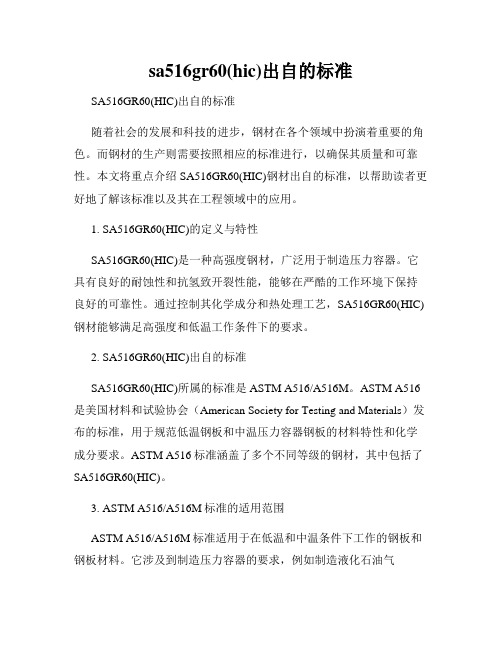
sa516gr60(hic)出自的标准SA516GR60(HIC)出自的标准随着社会的发展和科技的进步,钢材在各个领域中扮演着重要的角色。
而钢材的生产则需要按照相应的标准进行,以确保其质量和可靠性。
本文将重点介绍SA516GR60(HIC)钢材出自的标准,以帮助读者更好地了解该标准以及其在工程领域中的应用。
1. SA516GR60(HIC)的定义与特性SA516GR60(HIC)是一种高强度钢材,广泛用于制造压力容器。
它具有良好的耐蚀性和抗氢致开裂性能,能够在严酷的工作环境下保持良好的可靠性。
通过控制其化学成分和热处理工艺,SA516GR60(HIC)钢材能够满足高强度和低温工作条件下的要求。
2. SA516GR60(HIC)出自的标准SA516GR60(HIC)所属的标准是ASTM A516/A516M。
ASTM A516是美国材料和试验协会(American Society for Testing and Materials)发布的标准,用于规范低温钢板和中温压力容器钢板的材料特性和化学成分要求。
ASTM A516标准涵盖了多个不同等级的钢材,其中包括了SA516GR60(HIC)。
3. ASTM A516/A516M标准的适用范围ASTM A516/A516M标准适用于在低温和中温条件下工作的钢板和钢板材料。
它涉及到制造压力容器的要求,例如制造液化石油气(LPG)容器、氨气储存罐、液化天然气(LNG)储存罐等。
ASTM A516标准所规定的钢材能够在高压、低温和腐蚀环境下保持较好的材料性能和可靠性。
4. SA516GR60(HIC)钢材在工程领域中的应用由于其良好的耐蚀性和抗氢致开裂性能,SA516GR60(HIC)钢材在各种工程领域中得到广泛应用。
它常用于制造化工压力容器、石油和天然气储存设备、核电站设备以及海洋平台等工程项目。
SA516GR60(HIC)钢材能够满足对高强度、低温和耐蚀性能的要求,保证了工程项目的安全性和可靠性。
压力容器专用钢板标准简介

PPT文档演模板
压力容器专用钢板标准简介
标 准 GB19189-2003 GB19189-(2010)
钢号
12MnNiVR
12MnNiVR
板 厚 mm
12~60
12~60
Rm MPa
610~730
610~730
ReL (Rp0.2)MPa -20℃ KV2 J
≥490 ≥47
≥490 ≥80
PPT文档演模板
钢号
厚度 mm
P%
16MnDR 6~60 ≤0.025
S % ≤0.012
-40℃ KV2 J
横向,≥34
P355NL1
SA516Gr.70+S5
≤60
>25~50
≤0.025 ≤0.015
≤0.035 ≤0.035
横向,≥27
纵向,≥20
PPT文档演模板
压力容器专用钢板标准简介
2. 09MnNiDR钢板
≤0.025 0℃,≥34
≤0.010
0℃,≥41 (-20℃,≥41 )
• PSR=Cr+Cu+2Mo+10V+7Nb+5Ti-2( % )
PPT文档演模板
压力容器专用钢板标准简介
5. 15CrMoR钢板 (1)钢号简介 (2)磷、硫含量
标 准 GB713-2008 EN10028-2:2003 ASME(2010)
•3. 07MnNiMoDR钢板
标 准 GB19189-(2010) GB19189-(2010)
钢号
07MnNiVDR
07MnNiMoDR
Ni %
0.20~0.50
0.30~0.60
SA515Gr60 SA515Gr65 SA515Gr70技术参数

70(485)
70-90(485-620)
205
2.引用标准:
A20/A20M 压力容器用钢板通用要求
3.材料和制造
炼钢工艺-钢应为镇静钢,并应符合A20/A20M标准细奥氏体晶粒度的要求。
4.热处理
4.1 厚度小于或等于2in(50mm)的钢板通常以轧制状态供货。可以订购正火处理的、或消除应力处理的或正火加消除应力处理的钢板。
4.2 厚度大于2in(50mm)的钢板必须经正火处理。
5化学成分
元素
成分,%
60(415)级
65(450)级
70(485)级
C①
板厚≤1in.(25mm)
≤0.24
≤0.28
≤0.31
板厚>1in.-2in.(25~50mm)
≤0.27
≤0.31
≤0.33
板厚>2in.~4in.(50~100mm)
≤0.035
≤0.035
Si
熔炼分析
0.15~0.40
0.15~0.40
0.15~0.40
成品分析
0.13~0.45
0.13~0.45
0.13~0.45
①对熔炼分析和成品分析均适应。
6 力学性能
项目
60(415)级
65(450)级
70(485)级
抗拉强度,ksi(MPa)
60~80
(415~550)
1.SA515/SA515M中低温压力容器用碳钢板
本标准适用于对缺口韧性有较高要求的焊接压力容器用碳素钢板。
本标准中的钢板分为如下四个强度级别:
牌号
级别U.S
抗拉强度,ksi(MPa)
最大厚度,in.(mm)
ASTM+A516&A516M-2004+中温及低温压力容器用碳素钢板

Designation:A516/A516M–04Used in USDOE-NE StandardsStandard Specification forPressure Vessel Plates,Carbon Steel,for Moderate-andLower-Temperature Service1This standard is issued under thefixed designation A516/A516M;the number immediately following the designation indicates the yearof original adoption or,in the case of revision,the year of last revision.A number in parentheses indicates the year of last reapproval.A superscript epsilon(e)indicates an editorial change since the last revision or reapproval.This standard has been approved for use by agencies of the Department of Defense.1.Scope*1.1This specification2covers carbon steel plates intendedprimarily for service in welded pressure vessels where im-proved notch toughness is important.1.2Plates under this specification are available in fourgrades having different strength levels as follows:Grade U.S.[SI]Tensile Strength, ksi[MPa]55[380]55–75[380–515]60[415]60–80[415–550]65[450]65–85[450–585]70[485]70–90[485–620]1.3The maximum thickness of plates is limited only by the capacity of the composition to meet the specified mechanical property requirements;however,current practice normally limits the maximum thickness of plates furnished under this specification as follows:Grade U.S.[SI]Maximum Thickness,in.[mm]55[380]12[305]60[415]8[205]65[450]8[205]70[485]8[205]1.4For plates produced from coil and furnished without heat treatment or with stress relieving only,the additional requirements,including additional testing requirements and the reporting of additional test results of Specification A20/A20M apply.1.5The values stated in either inch-pound units or SI units are to be regarded separately as standard.Within the text,the SI units are shown in brackets.The values stated in each system are not exact equivalents;therefore,each system must be used independently of the bining values from the two systems may result in nonconformance with the specifi-cation.2.Referenced Documents2.1ASTM Standards:3A20/A20M Specification for General Requirements for Steel Plates for Pressure VesselsA435/A435M Specification for Straight-Beam Ultrasonic Examination of Steel PlatesA577/A577M Specification for Ultrasonic Angle-Beam Examination of Steel PlatesA578/A578M Specification for Straight-Beam Ultrasonic Examination of Plain and Clad Steel Plates for Special Applications3.General Requirements and Ordering Information3.1Plates supplied to this product specification shall con-form to Specification A20/A20M,which outlines the testing and retesting methods and procedures,permissible variations in dimensions and mass,quality and repair of defects,marking, loading,and so forth.3.2Specification A20/A20M also establishes the rules for ordering information that should be complied with when purchasing plates to this specification.3.3In addition to the basic requirements of this specifica-tion,certain supplementary requirements are available where additional control,testing,or examination is required to meet end use requirements.3.4The purchaser is referred to the listed supplementary requirements in this specification and to the detailed require-ments in Specification A20/A20M.3.5Coils are excluded from qualification to this specifica-tion until they are processed intofinished plates.Plates produced from coil means plates that have been cut to individual lengths from coil.The processor directly controls,or is responsible for,the operations involved in the processing of coils intofinished plates.Such operations include decoiling, leveling,cutting to length,testing,inspection,conditioning, heat treatment(if applicable),packaging,marking,loading for shipment,and certification.1This specification is under the jurisdiction of ASTM Committee A01on Steel, Stainless Steel,and Related Alloys and is the direct responsibility of Subcommittee A01.11on Steel Plates for Boilers and Pressure Vessels.Current edition approved June1,2004.Published June2004.Originally approved st previous edition approved in2003as A516/A516M–03.2For ASME Boiler and Pressure Vessel Code applications,see related Specifi-cation SA-516/SA-516M in Section II of that Code.3For referenced ASTM standards,visit the ASTM website,,or contact ASTM Customer Service at service@.For Annual Book of ASTM Standards volume information,refer to the standard’s Document Summary page on the ASTM website.1*A Summary of Changes section appears at the end of this standard. Copyright©ASTM International,100Barr Harbor Drive,PO Box C700,West Conshohocken,PA19428-2959,United States.N OTE 1—For plates produced from coil and furnished without heat treatment or with stress relieving only,three test results are reported for each qualifying coil.Additional requirements regarding plate produced from coil are described in Specification A 20/A 20M.3.6If the requirements of this specification are in conflict with the requirements of Specification A 20/A20M,the re-quirements of this specification shall prevail.4.Materials and Manufacture4.1Steelmaking Practice —The steel shall be killed and shall conform to the fine austenitic grain size requirement of Specification A 20/A 20M.5.Heat Treatment5.1Plates 1.50in.[40mm]and under in thickness are normally supplied in the as-rolled condition.The plates may be ordered normalized or stress relieved,or both.5.2Plates over 1.50in.[40mm]in thickness shall be normalized.5.3When notch-toughness tests are required on plates 11⁄2in.[40mm]and under in thickness,the plates shall be normalized unless otherwise specified by the purchaser.5.4If approved by the purchaser,cooling rates faster than those obtained by cooling in air are permissible for improve-ment of the toughness,provided the plates are subsequently tempered in the temperature range 1100to 1300°F [595to 705°C].6.Chemical Composition6.1The steel shall conform to the chemical requirements given in Table 1unless otherwise modified in accordance with Supplementary Requirement S17,Vacuum Carbon-Deoxidized Steel,in Specification A 20/A20M.7.Mechanical Properties7.1Tension Test —The plates,as represented by the tension test specimens,shall conform to the requirements given in Table 2.TABLE 1Chemical RequirementsElementsComposition,%Grade 55[Grade 380]Grade 60[Grade 415]Grade 65[Grade 450]Grade 70[Grade 485]Carbon,max A ,B :1/2in.[12.5mm]and under0.180.210.240.27Over 1/2in.to 2in.[12.5to 50mm],incl 0.200.230.260.28Over 2in.to 4in.[50to 100mm],incl 0.220.250.280.30Over 4to 8in.[100to 200mm],incl 0.240.270.290.31Over 8in.[200mm]0.260.270.290.31Manganese:1/2in.[12.5mm]and under:Heat analysis B0.60–0.900.60–0.900.85–1.200.85–1.20Product analysis B0.55–0.980.55–0.980.79–1.300.79–1.30Over 1/2in.[12.5mm]:Heat analysis 0.60–1.200.85–1.200.85–1.200.85–1.20Product analysis 0.55–1.300.79–1.300.79–1.300.79–1.30Phosphorus,max A 0.0350.0350.0350.035Sulfur,max A 0.0350.0350.0350.035Silicon:Heat analysis B0.15–0.400.15–0.400.15–0.400.15–0.40Product analysis B0.13–0.450.13–0.450.13–0.450.13–0.45A Applies to both heat and product analyses.BFor each reduction of 0.01percentage point below the specified maximum for carbon,an increase of 0.06percentage point above the specified maximum for manganese is permitted,up to a maximum of 1.50%by heat analysis and 1.60%by productanalysis.SUPPLEMENTARY REQUIREMENTSSupplementary requirements shall not apply unless specified in the purchase order.A list of standardized supplementary requirements for use at the option of the purchaser is included in ASTM Specification A 20/A 20M.Those that are considered suitable for use with this specification are listed below by title.S1.Vacuum Treatment,S2.Product Analysis,S3.Simulated Post-Weld Heat Treatment of Mechanical Test Coupons,S4.1Additional Tension Test,S5.Charpy V-Notch Impact Test,S6.Drop Weight Test,S7.High-Temperature Tension Test,S8.Ultrasonic Examination in accordance with Specifica-tion A 435/A 435M,S9.Magnetic Particle Examination,S11.Ultrasonic Examination in accordance with Specifica-tion A 577/A 577M,S12.Ultrasonic Examination in accordance with Specifica-tion A 578/A 578M,andS17.Vacuum Carbon-Deoxidized Steel.SUMMARY OF CHANGESCommittee A01has identified the location of selected changes to this standard since the last issue (A 516/A 516M –03)that may impact the use of this standard.(Approved June 1,2004.)(1)Footnote B in Table 1was revised.Committee A01has identified the location of selected changes to this standard since the last issue (A 516/A 516M –01)thatmay impact the use of this standard.(Approved Sept.10,2003.)(1)1.4,3.5,and Note 1were revised to be consistent with the terminology and requirements of Specification A 20/A 20M.(2)3.3was revised to be more general.ASTM International takes no position respecting the validity of any patent rights asserted in connection with any item mentioned in this ers of this standard are expressly advised that determination of the validity of any such patent rights,and the risk of infringement of such rights,are entirely their own responsibility.This standard is subject to revision at any time by the responsible technical committee and must be reviewed every five years and if not revised,either reapproved or withdrawn.Your comments are invited either for revision of this standard or for additional standards and should be addressed to ASTM International Headquarters.Your comments will receive careful consideration at a meeting of the responsible technical committee,which you may attend.If you feel that your comments have not received a fair hearing you should make your views known to the ASTM Committee on Standards,at the address shown below.This standard is copyrighted by ASTM International,100Barr Harbor Drive,PO Box C700,West Conshohocken,PA 19428-2959,United States.Individual reprints (single or multiple copies)of this standard may be obtained by contacting ASTM at the above address or at 610-832-9585(phone),610-832-9555(fax),or service@ (e-mail);or through the ASTM website ().TABLE 2Tensile RequirementsGrade55[380]60[415]65[450]70[485]Tensile strength,ksi [MPa]55–75[380–515]60–80[415–550]65–85[450–585]70–90[485–620]Yield strength,min,A ksi [MPa]30[205]32[220]35[240]38[260]Elongation in 8in.[200mm],min,%B 23211917Elongation in 2in.[50mm],min,%B27252321A Determined by either the 0.2%offset method or the 0.5%extension-under-load method.BSee Specification A 20/A20M for elongationadjustment.。
SA515中低温压力容器用碳钢板

SA515/SA515M 中低温压力容器用碳钢板
1、SA515标准下有四种材质,分别是:SA515Gr60、SA515Gr65、SA515Gr70.
1.1 钢板的最大厚度仅受化学成分满足规定力学性能要求的能力限制,
但现在通常将按本标准供应的钢板最大厚度限制如下:
2、SA515炼钢工艺:钢应为镇静钢,并符合A20/A20M 标准细奥氏体晶粒度的要求。
3、SA515热处理:
3.1 厚度小于等于2in.(50mm )的钢板通常以轧制状态供货。
可以订购正火处理的、或消除应力处理的正火加消除应力处理的钢板。
3.2 厚度大于2in.(50mm )的钢板必须经过正火处理。
①对于熔炼分析和成品分析均适用。
①用0.2%残余变形法或载荷下的0.5%伸长测定。
压力容器用碳素钢和低合金钢厚钢板

压力容器用碳素钢和低合金钢厚钢板压力容器是一种用于封闭和承受高压气体或液体的设备。
在设计和制造压力容器时,选择适当的材料对于保证容器的安全性和可靠性至关重要。
碳素钢和低合金钢是两种常用的材料,在厚钢板领域有着广泛的应用。
碳素钢是指含有碳元素的钢材,其碳含量在0.08%-2.0%之间。
由于碳素钢具有良好的可焊接性、可加工性和低成本等优点,因此在一些低压和中压容器的制造中广泛应用。
碳素钢具有较高的强度和硬度,并且能够承受一定的压力和温度。
同时,碳素钢还能够抵抗一些腐蚀性介质的侵蚀,具有较好的耐久性。
因此,在一些常规应用场景中,碳素钢是一种性价比很高的材料选择。
低合金钢是指含有一定数量的合金元素(如铬、镍、钼等)的钢材。
这些合金元素能够提高钢材的硬度、强度和耐腐蚀性能,从而使钢材具备更高的承压能力和耐久性。
低合金钢通常具有较高的强度和韧性,因此在一些高压容器和要求较高承压能力的容器中被广泛应用。
与碳素钢相比,低合金钢的成本较高,但在一些特殊工况和需求较高的领域,低合金钢具有不可替代的优势。
无论是碳素钢还是低合金钢,对于压力容器的生产和使用来说,关键在于正确的材料选择和合理的设计。
在实际应用中,需要根据容器所承受的压力、温度和介质性质等因素来选择合适的材料。
同时,还需要根据设计标准和规范进行合理的计算和选择,以确保容器的安全运行。
总之,碳素钢和低合金钢是压力容器材料的常见选择。
碳素钢具有良好的可焊接性和可加工性,适用于一些低压和中压容器的制造;低合金钢则能够提供更高的承压能力和耐久性,适用于一些高压容器和特殊工况的需求。
在实际应用中,需要根据具体情况进行合理选择,并按照标准和规范进行设计和制造,以确保容器的安全性和可靠性。
压力容器是在工业生产中广泛使用的一种设备,承载着重要的作用,可用于贮存和输送各种液体、气体或者气液两相的物质。
由于其工作环境特殊,容器内部所受的压力远大于常压,因此压力容器的制造材料对于其的安全性和可靠性至关重要。
sa516gr60是什么材质
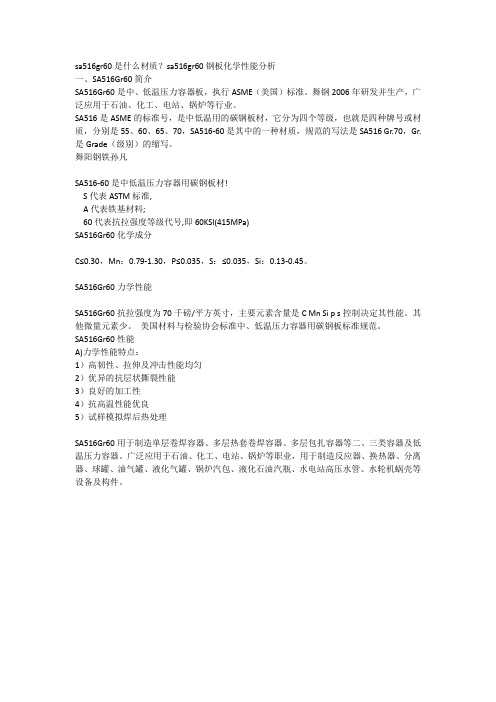
sa516gr60是什么材质?sa516gr60钢板化学性能分析
一、SA516Gr60简介
SA516Gr60是中、低温压力容器板,执行ASME(美国)标准。
舞钢2006年研发并生产,广泛应用于石油、化工、电站、锅炉等行业。
SA516是ASME的标准号,是中低温用的碳钢板材,它分为四个等级,也就是四种牌号或材质,分别是55、60、65、70,SA516-60是其中的一种材质,规范的写法是SA516 Gr.70,Gr.是Grade(级别)的缩写。
舞阳钢铁孙凡
SA516-60是中低温压力容器用碳钢板材!
S代表ASTM标准,
A代表铁基材料;
60代表抗拉强度等级代号,即60KSI(415MPa)
SA516Gr60化学成分
C≤0.30,Mn:0.79-1.30,P≤0.035,S:≤0.035,Si:0.13-0.45。
SA516Gr60力学性能
SA516Gr60抗拉强度为70千磅/平方英寸,主要元素含量是C Mn Si p s控制决定其性能。
其他微量元素少。
美国材料与检验协会标准中、低温压力容器用碳钢板标准规范。
SA516Gr60性能
A)力学性能特点:
1)高韧性、拉伸及冲击性能均匀
2)优异的抗层状撕裂性能
3)良好的加工性
4)抗高温性能优良
5)试样模拟焊后热处理
SA516Gr60用于制造单层卷焊容器、多层热套卷焊容器、多层包扎容器等二、三类容器及低温压力容器。
广泛应用于石油、化工、电站、锅炉等职业,用于制造反应器、换热器、分离器、球罐、油气罐、液化气罐、锅炉汽包、液化石油汽瓶、水电站高压水管、水轮机蜗壳等设备及构件。
SA516Gr70与SA516Gr70N的区别
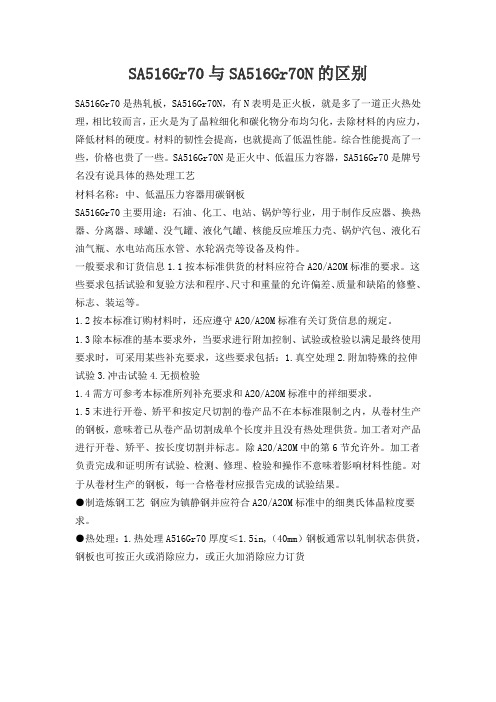
SA516Gr70与SA516Gr70N的区别SA516Gr70是热轧板,SA516Gr70N,有N表明是正火板,就是多了一道正火热处理,相比较而言,正火是为了晶粒细化和碳化物分布均匀化,去除材料的内应力,降低材料的硬度。
材料的韧性会提高,也就提高了低温性能。
综合性能提高了一些,价格也贵了一些。
SA516Gr70N是正火中、低温压力容器,SA516Gr70是牌号名没有说具体的热处理工艺材料名称:中、低温压力容器用碳钢板SA516Gr70主要用途:石油、化工、电站、锅炉等行业,用于制作反应器、换热器、分离器、球罐、没气罐、液化气罐、核能反应堆压力壳、锅炉汽包、液化石油气瓶、水电站高压水管、水轮涡壳等设备及构件。
一般要求和订货信息1.1按本标准供货的材料应符合A20/A20M标准的要求。
这些要求包括试验和复验方法和程序、尺寸和重量的允许偏差、质量和缺陷的修整、标志、装运等。
1.2按本标准订购材料时,还应遵守A20/A20M标准有关订货信息的规定。
1.3除本标准的基本要求外,当要求进行附加控制、试验或检验以满足最终使用要求时,可采用某些补充要求,这些要求包括:1.真空处理2.附加特殊的拉伸试验3.冲击试验4.无损检验1.4需方可参考本标准所列补充要求和A20/A20M标准中的祥细要求。
1.5末进行开卷、矫平和按定尺切割的卷产品不在本标准限制之内,从卷材生产的钢板,意味着已从卷产品切割成单个长度并且没有热处理供货。
加工者对产品进行开卷、矫平、按长度切割并标志。
除A20/A20M中的第6节允许外。
加工者负责完成和证明所有试验、检测、修理、检验和操作不意味着影响材料性能。
对于从卷材生产的钢板,每一合格卷材应报告完成的试验结果。
●制造炼钢工艺钢应为镇静钢并应符合A20/A20M标准中的细奥氏体晶粒度要求。
●热处理:1.热处理A516Gr70厚度≤1.5in,(40mm)钢板通常以轧制状态供货,钢板也可按正火或消除应力,或正火加消除应力订货。
astm sa516 使用温度下限
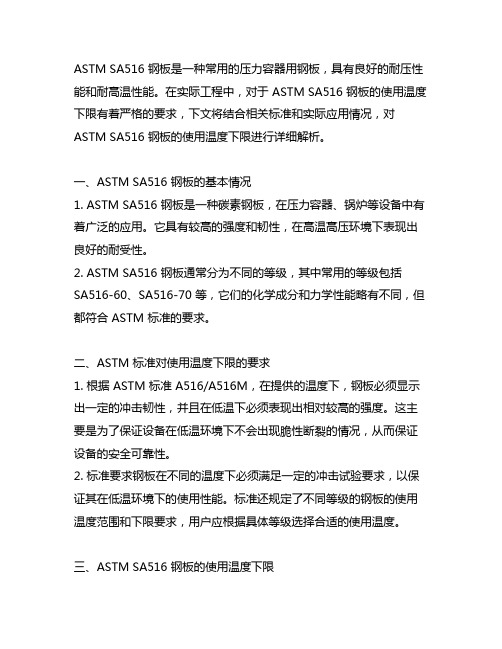
ASTM SA516 钢板是一种常用的压力容器用钢板,具有良好的耐压性能和耐高温性能。
在实际工程中,对于 ASTM SA516 钢板的使用温度下限有着严格的要求,下文将结合相关标准和实际应用情况,对ASTM SA516 钢板的使用温度下限进行详细解析。
一、ASTM SA516 钢板的基本情况1. ASTM SA516 钢板是一种碳素钢板,在压力容器、锅炉等设备中有着广泛的应用。
它具有较高的强度和韧性,在高温高压环境下表现出良好的耐受性。
2. ASTM SA516 钢板通常分为不同的等级,其中常用的等级包括SA516-60、SA516-70 等,它们的化学成分和力学性能略有不同,但都符合 ASTM 标准的要求。
二、ASTM 标准对使用温度下限的要求1. 根据 ASTM 标准 A516/A516M,在提供的温度下,钢板必须显示出一定的冲击韧性,并且在低温下必须表现出相对较高的强度。
这主要是为了保证设备在低温环境下不会出现脆性断裂的情况,从而保证设备的安全可靠性。
2. 标准要求钢板在不同的温度下必须满足一定的冲击试验要求,以保证其在低温环境下的使用性能。
标准还规定了不同等级的钢板的使用温度范围和下限要求,用户应根据具体等级选择合适的使用温度。
三、ASTM SA516 钢板的使用温度下限1. 对于常用的 SA516-70 钢板,其使用温度下限一般为-46℃。
在低于这一温度时,SA516-70 钢板可能会出现冷脆断裂的风险,因此在选择材料和设计设备时需要考虑到这一因素。
四、影响 ASTM SA516 钢板使用温度下限的因素1. 化学成分:钢材的化学成分将直接影响其低温性能,例如含碳量、合金元素的添加等都会对其低温韧性产生影响。
2. 热处理工艺:恰当的热处理工艺可以改善钢材的低温性能,通过控制退火温度和时间等参数,可以使钢材具有更好的抗冲击性能和低温韧性。
3. 设备设计:在实际使用中,设备的结构设计及工作条件也会对钢材的低温使用性能产生影响,合理的设计可以减少设备在低温环境下的应力集中,并提高钢材的低温使用温度下限。
中低温压力容器用碳钢板SA516MGr.485

中、低温压力容器用碳钢板SA516MGr.485
SA516MGr.485钢板执行标准:SA516/SA516M
SA516MGr.485钢板同标准下的材质有:SA516Gr55、SA516Gr60、SA516Gr65、SA516Gr70、SA516MGr380、SA516MGr415、SA516MGr450、SA516MGr485。
SA516MGr.485钢板热处理要求:厚度小于或等于40mm的SA516MGr.485钢板通常以热轧状态净化,也可以正火热处理、回火热处理或者正火+回火热处理。
厚度大于40mm的SA516MGr.485钢板必须进行正火热处理。
注:如果厚度小于40mm的SA516MGr.485钢板要求进行缺口韧性试验,则SA516MGr.485钢板需要进行正火热处理。
中、低温压力容器用碳钢板SA516MGr.485关键词:碳钢、碳钢板、承压零件、压力容器钢、压力容器用钢板
SA516MGr.485钢板化学成分
在规定的最大碳含量以下每降低0.01%,规定最大锰含量的上限可增加0.06%,熔炼分析最大允许到1.50%,成品分析最大允许到1.60%。
SA516MGr.485钢板力学性能(拉伸性能)
合同可以添加的补充要求:
S1:真空处理
S2:成品分析
S3:力学性能试样坯料的模拟焊后热处理
S4.1:附加的拉伸试验
S5:夏比V形缺口冲击试验
S6:落锤试验
S7:高温拉伸试验
S8:按A435/A435M标准进行的超声波检验S9:磁粉检验
S11:按A577/A577M标准进行的超声波检验S12:按A578/A578M标准进行的超声波检验S17:真空碳脱氧钢
SA516MGr.485钢板照片。
astm-516 碳钢板执行标准
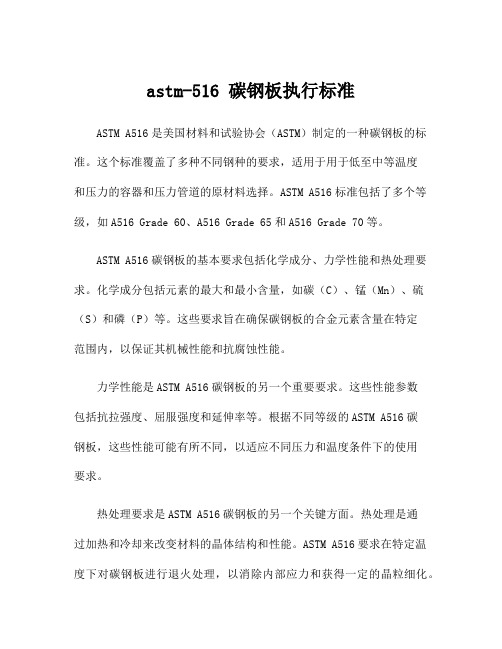
astm-516 碳钢板执行标准ASTM A516是美国材料和试验协会(ASTM)制定的一种碳钢板的标准。
这个标准覆盖了多种不同钢种的要求,适用于用于低至中等温度和压力的容器和压力管道的原材料选择。
ASTM A516标准包括了多个等级,如A516 Grade 60、A516 Grade 65和A516 Grade 70等。
ASTM A516碳钢板的基本要求包括化学成分、力学性能和热处理要求。
化学成分包括元素的最大和最小含量,如碳(C)、锰(Mn)、硫(S)和磷(P)等。
这些要求旨在确保碳钢板的合金元素含量在特定范围内,以保证其机械性能和抗腐蚀性能。
力学性能是ASTM A516碳钢板的另一个重要要求。
这些性能参数包括抗拉强度、屈服强度和延伸率等。
根据不同等级的ASTM A516碳钢板,这些性能可能有所不同,以适应不同压力和温度条件下的使用要求。
热处理要求是ASTM A516碳钢板的另一个关键方面。
热处理是通过加热和冷却来改变材料的晶体结构和性能。
ASTM A516要求在特定温度下对碳钢板进行退火处理,以消除内部应力和获得一定的晶粒细化。
ASTM A516标准的应用范围广泛。
它常被用于制造各种容器和压力管道,如锅炉、压力容器、燃气和石油管道等。
这些应用要求材料具有优异的耐压性能和耐腐蚀性能,以确保设备在高压和恶劣工况下的安全运行。
ASTM A516碳钢板的选择需要考虑多个因素,如压力、温度、材料成本等。
根据应用要求和预算限制,可以选择不同等级的碳钢板,以满足性能和经济性要求。
总之,ASTM A516碳钢板是一种用于制造容器和压力管道的常见材料。
它具有严格的化学成分、力学性能和热处理要求,以确保其适应各种工业应用的需求。
使用ASTM A516碳钢板可以在各种压力和温度条件下提供安全可靠的性能。
中低温压力容器用碳钢板SA516Gr70
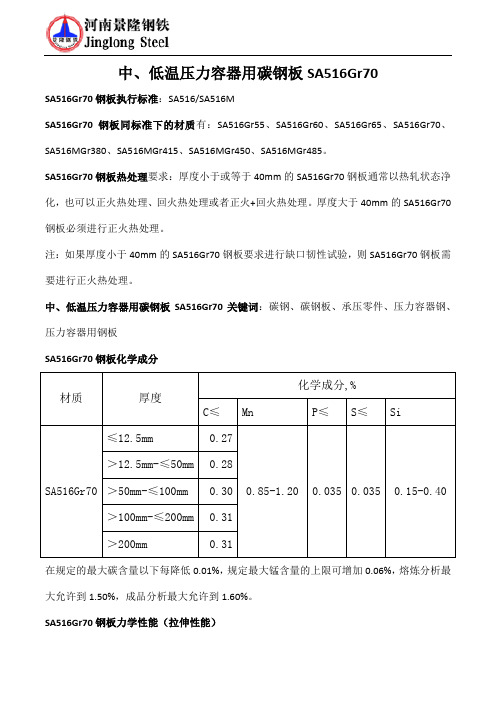
中、低温压力容器用碳钢板SA516Gr70
SA516Gr70钢板执行标准:SA516/SA516M
SA516Gr70钢板同标准下的材质有:SA516Gr55、SA516Gr60、SA516Gr65、SA516Gr70、SA516MGr380、SA516MGr415、SA516MGr450、SA516MGr485。
SA516Gr70钢板热处理要求:厚度小于或等于40mm的SA516Gr70钢板通常以热轧状态净化,也可以正火热处理、回火热处理或者正火+回火热处理。
厚度大于40mm的SA516Gr70钢板必须进行正火热处理。
注:如果厚度小于40mm的SA516Gr70钢板要求进行缺口韧性试验,则SA516Gr70钢板需要进行正火热处理。
中、低温压力容器用碳钢板SA516Gr70关键词:碳钢、碳钢板、承压零件、压力容器钢、压力容器用钢板
SA516Gr70钢板化学成分
在规定的最大碳含量以下每降低0.01%,规定最大锰含量的上限可增加0.06%,熔炼分析最大允许到1.50%,成品分析最大允许到1.60%。
SA516Gr70钢板力学性能(拉伸性能)
合同可以添加的补充要求:
S1:真空处理
S2:成品分析
S3:力学性能试样坯料的模拟焊后热处理
S4.1:附加的拉伸试验
S5:夏比V 形缺口冲击试验
S6:落锤试验
S7:高温拉伸试验
S8:按A435/A435M 标准进行的超声波检验
S9:磁粉检验
S11:按A577/A577M 标准进行的超声波检验
S12:按A578/A578M 标准进行的超声波检验
S17:真空碳脱氧钢
SA516Gr70钢板实物照片。
516中温及低温压力容器用碳素钢板材的标准规范[1]
![516中温及低温压力容器用碳素钢板材的标准规范[1]](https://img.taocdn.com/s3/m/d50188a9d1f34693daef3ef7.png)
Designation:A516/A516M–06Used in USDOE-NE StandardsStandard Specification forPressure Vessel Plates,Carbon Steel,for Moderate-andLower-Temperature Service1This standard is issued under thefixed designation A516/A516M;the number immediately following the designation indicates the yearof original adoption or,in the case of revision,the year of last revision.A number in parentheses indicates the year of last reapproval.A superscript epsilon(e)indicates an editorial change since the last revision or reapproval.This standard has been approved for use by agencies of the Department of Defense.1.Scope*1.1This specification2covers carbon steel plates intendedprimarily for service in welded pressure vessels where im-proved notch toughness is important.1.2Plates under this specification are available in fourgrades having different strength levels as follows:Grade U.S.[SI]Tensile Strength, ksi[MPa]55[380]55–75[380–515]60[415]60–80[415–550]65[450]65–85[450–585]70[485]70–90[485–620]1.3The maximum thickness of plates is limited only by the capacity of the composition to meet the specified mechanical property requirements;however,current practice normally limits the maximum thickness of plates furnished under this specification as follows:Grade U.S.[SI]Maximum Thickness,in.[mm]55[380]12[305]60[415]8[205]65[450]8[205]70[485]8[205]1.4For plates produced from coil and furnished without heat treatment or with stress relieving only,the additional requirements,including additional testing requirements and the reporting of additional test results of Specification A20/A20M apply.1.5The values stated in either inch-pound units or SI units are to be regarded separately as standard.Within the text,the SI units are shown in brackets.The values stated in each system are not exact equivalents;therefore,each system must be used independently of the bining values from the two systems may result in nonconformance with the specifi-cation.2.Referenced Documents2.1ASTM Standards:3A20/A20M Specification for General Requirements for Steel Plates for Pressure VesselsA435/A435M Specification for Straight-Beam Ultrasonic Examination of Steel PlatesA577/A577M Specification for Ultrasonic Angle-Beam Examination of Steel PlatesA578/A578M Specification for Straight-Beam Ultrasonic Examination of Plain and Clad Steel Plates for Special Applications3.General Requirements and Ordering Information3.1Plates supplied to this product specification shall con-form to Specification A20/A20M,which outlines the testing and retesting methods and procedures,permissible variations in dimensions and mass,quality and repair of defects,marking, loading,and so forth.3.2Specification A20/A20M also establishes the rules for ordering information that should be complied with when purchasing plates to this specification.3.3In addition to the basic requirements of this specifica-tion,certain supplementary requirements are available where additional control,testing,or examination is required to meet end use requirements.3.4The purchaser is referred to the listed supplementary requirements in this specification and to the detailed require-ments in Specification A20/A20M.3.5Coils are excluded from qualification to this specifica-tion until they are processed intofinished plates.Plates produced from coil means plates that have been cut to individual lengths from coil.The processor directly controls,or is responsible for,the operations involved in the processing of coils intofinished plates.Such operations include decoiling, leveling,cutting to length,testing,inspection,conditioning, heat treatment(if applicable),packaging,marking,loading for shipment,and certification.1This specification is under the jurisdiction of ASTM Committee A01on Steel, Stainless Steel,and Related Alloys and is the direct responsibility of Subcommittee A01.11on Steel Plates for Boilers and Pressure Vessels.Current edition approved March1,2006.Published March2006.Originally approved st previous edition approved in2005as A516/A516M–05e1.2For ASME Boiler and Pressure Vessel Code applications,see related Specifi-cation SA-516/SA-516M in Section II of that Code.3For referenced ASTM standards,visit the ASTM website,,or contact ASTM Customer Service at service@.For Annual Book of ASTM Standards volume information,refer to the standard’s Document Summary page on the ASTM website.*A Summary of Changes section appears at the end of this standard. Copyright©ASTM International,100Barr Harbor Drive,PO Box C700,West Conshohocken,PA19428-2959,United States.--` ` ` ` ` , , , ` ` , ` , , ` , ` , ` , , ` ` , , , -` -` , , ` , , ` , ` , , ` ---N OTE1—For plates produced from coil and furnished without heat treatment or with stress relieving only,three test results are reported for each qualifying coil.Additional requirements regarding plate produced from coil are described in Specification A20/A20M.3.6If the requirements of this specification are in conflict with the requirements of Specification A20/A20M,the re-quirements of this specification shall prevail.4.Materials and Manufacture4.1Steelmaking Practice—The steel shall be killed and shall conform to thefine austenitic grain size requirement of Specification A20/A20M.5.Heat Treatment5.1Plates1.50in.[40mm]and under in thickness are normally supplied in the as-rolled condition.The plates may be ordered normalized or stress relieved,or both.5.2Plates over 1.50in.[40mm]in thickness shall be normalized.5.3When notch-toughness tests are required on plates11⁄2 in.[40mm]and under in thickness,the plates shall be normalized unless otherwise specified by the purchaser.5.4If approved by the purchaser,cooling rates faster than those obtained by cooling in air are permissible for improve-ment of the toughness,provided the plates are subsequently tempered in the temperature range1100to1300°F[595to705°C].6.Chemical Composition6.1The steel shall conform to the chemical requirements given in Table1unless otherwise modified in accordance with Supplementary Requirement S17,Vacuum Carbon-Deoxidized Steel,in Specification A20/A20M.7.Mechanical Properties7.1Tension Test—The plates,as represented by the tension test specimens,shall conform to the requirements given in Table2.8.Keywords8.1carbon steel;carbon steel plate;pressure containing parts;pressure vessel steels;steel plates for pressure vesselsTABLE1Chemical RequirementsA Applies to both heat and product analyses.B For each reduction of0.01percentage point below the specified maximum for carbon,an increase of0.06percentage point above the specified maximum for manganese is permitted,up to a maximum of1.50%by heat analysis and1.60%by product analysis.C Grade60plates1⁄2in.[12.5mm]and under in thickness may have0.85–1.20%manganese on heat analysis,and0.79–1.30%manganese on product analysis.SUPPLEMENTARY REQUIREMENTSSupplementary requirements shall not apply unless specified in the purchase order.A list of standardized supplementary requirements for use at the option of the purchaser is included in ASTM Specification A 20/A 20M.Those that are considered suitable for use with this specification are listed below by title.S1.Vacuum Treatment,S2.Product Analysis,S3.Simulated Post-Weld Heat Treatment of Mechanical Test Coupons,S4.1Additional Tension Test,S5.Charpy V-Notch Impact Test,S6.Drop Weight Test (for Material 0.625in.[16mm]and over in Thickness),S7.High-Temperature Tension Test,S8.Ultrasonic Examination in accordance with Specifica-tion A 435/A 435M,S9.Magnetic Particle Examination,S11.Ultrasonic Examination in accordance with Specifica-tion A 577/A 577M,S12.Ultrasonic Examination in accordance with Specifica-tion A 578/A 578M,andS17.Vacuum Carbon-Deoxidized Steel.ADDITIONAL SUPPLEMENTARY REQUIREMENTSIn addition,the following supplementary requirement is suitable for this application.S54.Requirements for Carbon Steel Plate forHydrofluoric Acid Alkylation ServiceS54.1Plates shall be provided in the normalized heat-treated condition.S54.2The maximum carbon equivalent shall be as follows:Plate thickness less than or equal to 1in.[25mm]:CE maximum =0.43Plate thickness greater than 1in.[25mm]:CE maximum =0.45S54.3Determine the carbon equivalent (CE)as follows:CE 5C 1Mn /61~Cr 1Mo 1V !/51~Ni 1Cu !/15S54.4Vanadium and niobium maximum content based on heat analysis shall be:Maximum vanadium =0.02%Maximum niobium =0.02%Maximum vanadium plus niobium =0.03%(Note:niobium =columbium)S54.5The maximum composition based on heat analysis of Ni +Cu shall be 0.15%.S54.6The minimum C content based on heat analysis shall be 0.18%.The maximum C content shall be as specified for the ordered grade.S54.7Welding consumables for repair welds shall be of the low-hydrogen type.E60XX electrodes shall not be used and the resulting weld chemistry shall meet the same chemistry requirements as the base metal.S54.8In addition to the requirements for product marking in the specification,an “HF-N”stamp or marking shall be provided on each plate to identify that the plate complies with this supplementary requirement.TABLE 2Tensile RequirementsGrade55[380]60[415]65[450]70[485]Tensile strength,ksi [MPa]55–75[380–515]60–80[415–550]65–85[450–585]70–90[485–620]Yield strength,min,A ksi [MPa]30[205]32[220]35[240]38[260]Elongation in 8in.[200mm],min,%B 23211917Elongation in 2in.[50mm],min,%B27252321A Determined by either the 0.2%offset method or the 0.5%extension-under-load method.BSee Specification A 20/A20M for elongationadjustment.SUMMARY OF CHANGESCommittee A01has identified the location of selected changes to this standard since the last issue(A516/A516M–05e1)that may impact the use of this standard.(Approved March1,2006.)(1)Footnote C was added to Table1.Committee A01has identified the location of selected changes to this standard since the last issue(A516/A516M–03)that may impact the use of this standard.(Approved March1,2005.)(1)Keywords were added.(2)Supplementary Requirement S1,for plates for HF alkyla-tion service,was added.(3)Table1was corrected editorially.ASTM International takes no position respecting the validity of any patent rights asserted in connection with any item mentioned in this ers of this standard are expressly advised that determination of the validity of any such patent rights,and the risk of infringement of such rights,are entirely their own responsibility.This standard is subject to revision at any time by the responsible technical committee and must be reviewed everyfive years and if not revised,either reapproved or withdrawn.Your comments are invited either for revision of this standard or for additional standards and should be addressed to ASTM International Headquarters.Your comments will receive careful consideration at a meeting of the responsible technical committee,which you may attend.If you feel that your comments have not received a fair hearing you should make your views known to the ASTM Committee on Standards,at the address shown below.This standard is copyrighted by ASTM International,100Barr Harbor Drive,PO Box C700,West Conshohocken,PA19428-2959, United States.Individual reprints(single or multiple copies)of this standard may be obtained by contacting ASTM at the above address or at610-832-9585(phone),610-832-9555(fax),or service@(e-mail);or through the ASTM website ().。
解读美国ASME规范中SA-516材料
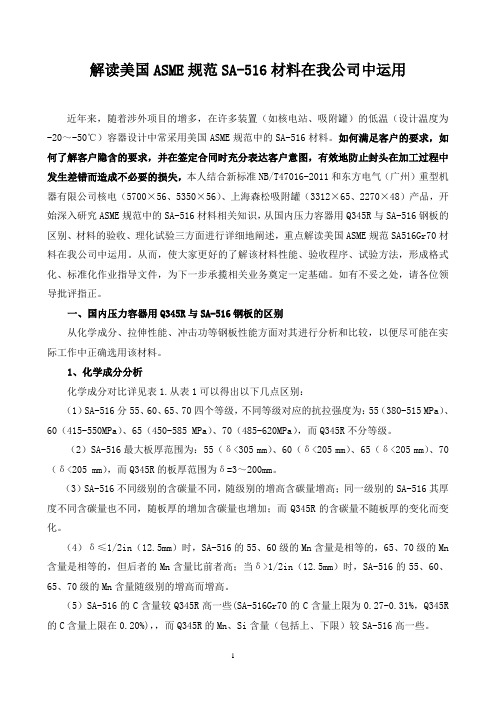
解读美国ASME规范SA-516材料在我公司中运用近年来,随着涉外项目的增多,在许多装置(如核电站、吸附罐)的低温(设计温度为-20~-50℃)容器设计中常采用美国ASME规范中的SA-516材料。
如何满足客户的要求,如何了解客户隐含的要求,并在签定合同时充分表达客户意图,有效地防止封头在加工过程中发生差错而造成不必要的损失,本人结合新标准NB/T47016-2011和东方电气(广州)重型机器有限公司核电(5700×56、5350×56)、上海森松吸附罐(3312×65、2270×48)产品,开始深入研究ASME规范中的SA-516材料相关知识,从国内压力容器用Q345R与SA-516钢板的区别、材料的验收、理化试验三方面进行详细地阐述,重点解读美国ASME规范SA516Gr70材料在我公司中运用。
从而,使大家更好的了解该材料性能、验收程序、试验方法,形成格式化、标准化作业指导文件,为下一步承揽相关业务奠定一定基础。
如有不妥之处,请各位领导批评指正。
一、国内压力容器用Q345R与SA-516钢板的区别从化学成分、拉伸性能、冲击功等钢板性能方面对其进行分析和比较,以便尽可能在实际工作中正确选用该材料。
1、化学成分分析化学成分对比详见表1.从表1可以得出以下几点区别:(1)SA-516分55、60、65、70四个等级,不同等级对应的抗拉强度为:55(380-515 MPa)、60(415-550MPa)、65(450-585 MPa)、70(485-620MPa),而Q345R不分等级。
(2)SA-516最大板厚范围为:55(δ<305 mm)、60(δ<205 mm)、65(δ<205 mm)、70 (δ<205 mm),而Q345R的板厚范围为δ=3~200mm。
(3)SA-516不同级别的含碳量不同,随级别的增高含碳量增高;同一级别的SA-516其厚度不同含碳量也不同,随板厚的增加含碳量也增加;而Q345R的含碳量不随板厚的变化而变化。
SA516GR.60化工石油用钢板
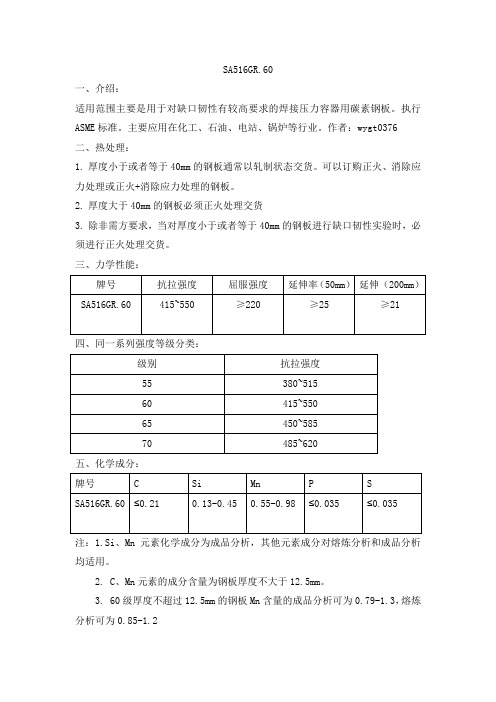
SA516GR.60
一、介绍:
适用范围主要是用于对缺口韧性有较高要求的焊接压力容器用碳素钢板。
执行ASME标准。
主要应用在化工、石油、电站、锅炉等行业。
作者:wygt0376
二、热处理:
1.厚度小于或者等于40mm的钢板通常以轧制状态交货。
可以订购正火、消除应力处理或正火+消除应力处理的钢板。
2.厚度大于40mm的钢板必须正火处理交货
3.除非需方要求,当对厚度小于或者等于40mm的钢板进行缺口韧性实验时,必须进行正火处理交货。
三、力学性能:
四、同一系列强度等级分类:
五、化学成分:
注:1.Si、Mn元素化学成分为成品分析,其他元素成分对熔炼分析和成品分析均适用。
2.C、Mn元素的成分含量为钢板厚度不大于12.5mm。
3.60级厚度不超过12.5mm的钢板Mn含量的成品分析可为0.79-1.3,熔炼分析可为0.85-1.2。
SA516Gr60HIC
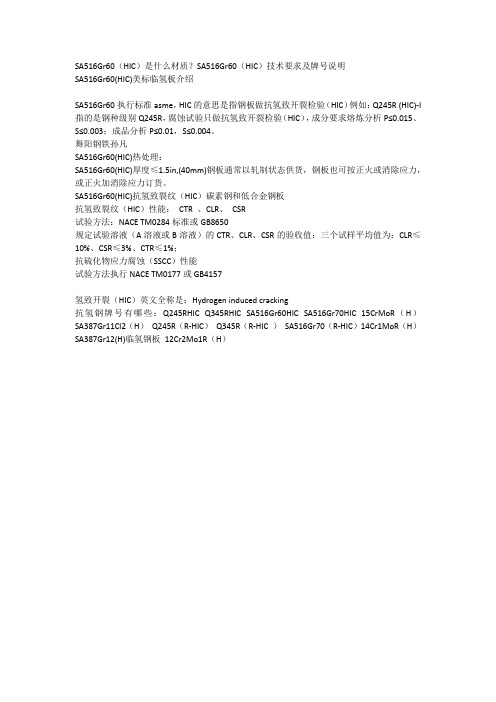
SA516Gr60(HIC)是什么材质?SA516Gr60(HIC)技术要求及牌号说明
SA516Gr60(HIC)美标临氢板介绍
SA516Gr60执行标准asme,HIC的意思是指钢板做抗氢致开裂检验(HIC)例如:Q245R (HIC)-I 指的是钢种级别Q245R,腐蚀试验只做抗氢致开裂检验(HIC),成分要求熔炼分析P≤0.015、S≤0.003;成品分析P≤0.01,S≤0.004。
舞阳钢铁孙凡
SA516Gr60(HIC)热处理:
SA516Gr60(HIC)厚度≤1.5in,(40mm)钢板通常以轧制状态供货,钢板也可按正火或消除应力,或正火加消除应力订货。
SA516Gr60(HIC)抗氢致裂纹(HIC)碳素钢和低合金钢板
抗氢致裂纹(HIC)性能:CTR 、CLR、CSR
试验方法:NACE TM0284标准或GB8650
规定试验溶液(A溶液或B溶液)的CTR、CLR、CSR的验收值:三个试样平均值为:CLR≤10%、CSR≤3%、CTR≤1%;
抗硫化物应力腐蚀(SSCC)性能
试验方法执行NACE TM0177或GB4157
氢致开裂(HIC)英文全称是:Hydrogen induced cracking
抗氢钢牌号有哪些:Q245RHIC Q345RHIC SA516Gr60HIC SA516Gr70HIC 15CrMoR(H)SA387Gr11Cl2(H)Q245R(R-HIC)Q345R(R-HIC )SA516Gr70(R-HIC)14Cr1MoR(H)SA387Gr12(H)临氢钢板12Cr2Mo1R(H)。
- 1、下载文档前请自行甄别文档内容的完整性,平台不提供额外的编辑、内容补充、找答案等附加服务。
- 2、"仅部分预览"的文档,不可在线预览部分如存在完整性等问题,可反馈申请退款(可完整预览的文档不适用该条件!)。
- 3、如文档侵犯您的权益,请联系客服反馈,我们会尽快为您处理(人工客服工作时间:9:00-18:30)。
中、低温压力容器用碳钢板SA516Gr60
SA516Gr60钢板执行标准:SA516/SA516M
对等标准:ASTM A516/A516M
SA516Gr60钢板同标准下的材质有:SA516Gr55、SA516Gr60、SA516Gr65、SA516Gr70、SA516MGr380、SA516MGr415、SA516MGr450、SA516MGr485。
SA516Gr60钢板热处理要求:厚度小于或等于40mm的SA516Gr60钢板通常以热轧状态净化,也可以正火热处理、回火热处理或者正火+回火热处理。
厚度大于40mm的SA516Gr60钢板必须进行正火热处理。
注:如果厚度小于40mm的SA516Gr60钢板要求进行缺口韧性试验,则SA516Gr60钢板需要进行正火热处理。
中、低温压力容器用碳钢板SA516Gr60关键词:碳钢、碳钢板、承压零件、压力容器钢、压力容器用钢板
SA516Gr60钢板化学成分
SA516Gr60厚度不超过12.5mm的钢板锰含量熔炼分析可为0.85-1.20%,成品分析0.79%-1.30%。
SA516Gr60钢板力学性能(拉伸性能)
合同可以添加的补充要求:
S1:真空处理
S2:成品分析
S3:力学性能试样坯料的模拟焊后热处理
S4.1:附加的拉伸试验
S5:夏比V 形缺口冲击试验
S6:落锤试验
S7:高温拉伸试验
S8:按A435/A435M 标准进行的超声波检验
S9:磁粉检验
S11:按A577/A577M 标准进行的超声波检验
S12:按A578/A578M 标准进行的超声波检验
S17:真空碳脱氧钢
0SA516Gr60钢板实物照片。
